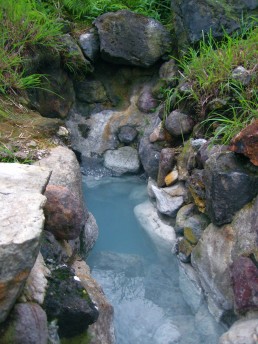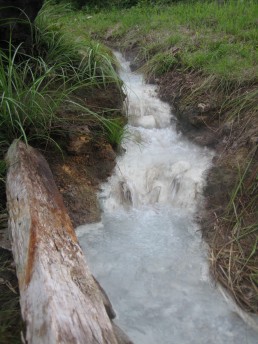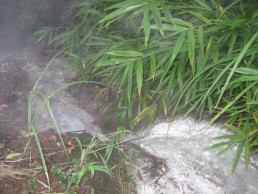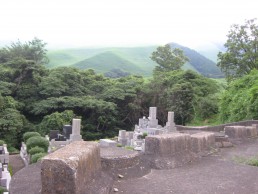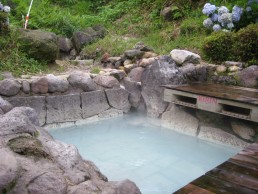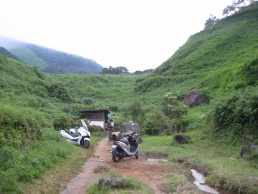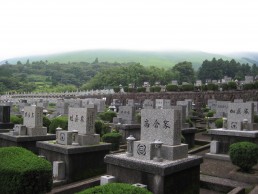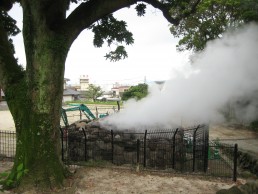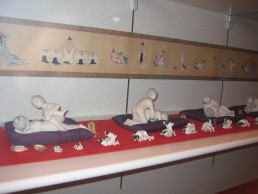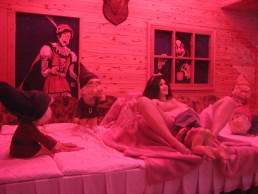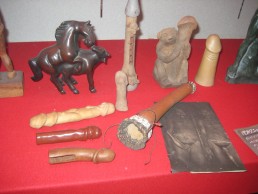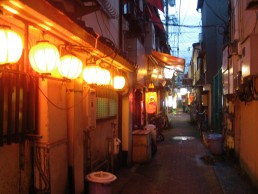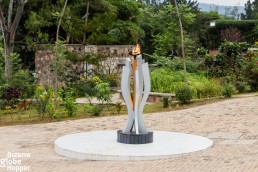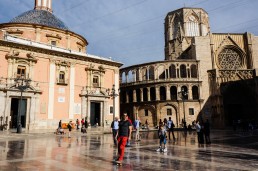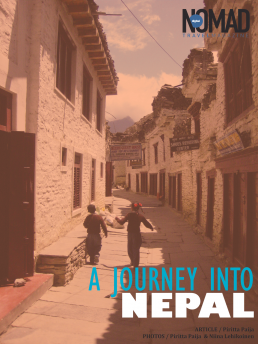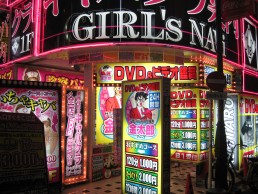Beppu has some of the best natural onsens of Japan. Because of the onsens, it has also been the capital of wild nightlife already for centuries. Today you can still find great onsens from the middle of lush nature and a sex museum you just can’t miss.
Beppu is perhaps best reached by train. We took a train from Fukuoka. All of the trains in Japan are also not Shinkansens, so reserve enough time for the journey.
Traditional Ryokans and Odd Japanese Customs in Beppu
I still remember how strange it felt when always when any one of the train’s staff either entered or left the carriage, they turned around and bowed to the passengers. I knew that bowing is an old cultural custom and that Japanese people are very courteous in general. But nevertheless, it felt odd to us westerners.
More traditions were waiting for us when we checked into our accommodation in Beppu, a ryokan called Nogami Honkan (1-12-1. Kitahama, Beppu). Ryokans are traditional Japanese guest houses which have tatami floors and other typical furniture, and they have a whole different atmosphere than in ordinary hotels. I recommend staying in a ryokan at least once on your trip to Japan. Otherwise, you’ll miss out something from the feeling of the old times, that they perfectly represent.
In our ryokan there was also a nice bonus – there were three onsens which you could book for private use. We immediately booked the best looking and biggest onsen for our first evening. Lying in a hot onsen is one of the most relaxing experiences I’ve ever had. Just remember to come and cool off regularly or you can get dizzy.
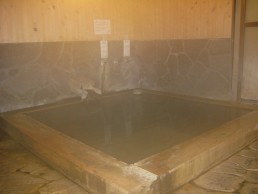
Bath in Some of the Best Onsens of Japan
Onsens, the iconic hot springs of Japan, are mineral-rich pools of water which are said to contain healing qualities. At least soaking yourself in them is incredibly relaxing, especially for aching muscles.
Beppu is particularly famous from its onsens, and it’s Japan’s most famous hot springs/onsen resort area. There are lots of onsens in the surrounding nature. Also, the best onsens are just those natural ones which are located in the wild and not purposefully built.
There are also the “Beppu Hells” (地獄 Jigoku in Japanese), multicolored volcanic pits of boiling water. These pools are too hot to be diluted into onsen and often have an unyielding smell of sulfur. Many of the Hells and onsens are in the Kannawa area. Stop by at The Foreign Tourist Information Office in the center of Beppu for some more information about the locations and on how to get there. Tourist Information has three branches around the city center.
How to Get to the Onsens
To get to many of the onsens, you’ll have to rent a scooter or a car and drive to them. Because we don’t have drivers’ licenses, we took the local bus to the nearest onsen we could reach. There was a short walk from the bus stop, but the route was an attraction itself. For example, after walking a while, we passed a graveyard where we took some eerie photographs. And after about 30-45 minutes walk we came to the onsen.
Getting lost on the way is almost impossible because your nose will lead the way from far away – you will smell the sulfur in the air, coming from the onsen.
The Onsen Etiquette
On the spot, there’s usually only a small wooden shack where people will change their clothes (it’s a unisex shed). Most of the times there will also be other people, mainly locals, having a bath. Even though nowadays a bathing suit is almost always required, occasionally people can still be naked when they bathe in the onsens. So try not to be distracted and just enjoy the experience. However, I must say that I’m a firm supporter of bathing suits.
The water in the onsens is usually almost scorching so don’t stay in for extended periods of time. Your body temperature will rise quickly when in such hot water, and it can also be dangerous if you stay too long.
Just stay in for about 5-10 mins at a time and then get out to cool off for awhile before dipping yourself in again. We noticed that Japanese men keep a towel on their head which has been drenched in cold water. This helps in cooling your body off.
Remember also to remove all your metal jewelry before dipping yourself in the onsens. Because if you don’t, the minerals of the water will corrode them and turn them into a greenish black. If you forget them on, your jewelry won’t be ruined forever, but you’ll have some hard time cleaning them.
A tip for the cleaning: just take an old toothbrush and brush them vigorously with toothpaste. After awhile your jewelry will be all shiny again!
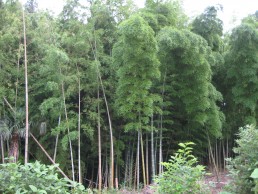
Hihōkan Sex Museum
Hours: 9 am – 10 pm
Address: 338-3 Shibuyu Kannawa
Beppu City, Oita Prefecture
Tel: 0977-66-8790 (local number)
NOTE: I'm not 100% sure are the
above opening hours still valid, so check them out somewhere before you go!
Beppu’s Vivid Nightlife
Beppu is a pretty small town, but it’s full of bars. There are also regular bars, but most of the places look like private clubs and hostess/host bars. Also, the nightlife of Beppu is still rumored to be pretty wild. It seemed that people come here to drink heavily and then on the day after they go to the onsens to cure their hangovers.
There is also a big Rehabilitation Center in Beppu. We came across it while we were hiking to the onsens. I think that it won’t have a lack of customers.
You can easily spend a few days in Beppu without getting bored. And if you’d like to party a bit, this is the place to be. We chose not to go bar hopping, but if you have some time to spare, give the famous nightlife of Beppu a chance. Just keep an eye on your money as I think you could easily spend a fortune in one night.
Or just take your visit as an extremely relaxation, like we did. Either way, you won’t be disappointed.
You May Also Like to Read:
When Reality Slaps You in the Face in the Genocide Memorial in Kigali, Rwanda
Getting a harsh reality check in the Kigali Genocide Memorial in Rwanda, where death and cruelty looked us straight in the eyes.
Valencia’s Old Town Merges Famous Sights With Street Art
Narrow alleys of El Carmen host a weird mix: subcultures and street art, orange gardens, old mansions, and the most iconic sights of the city.
Searching for the Alternative Tokyo
Venturing in Shibuya, Kabukicho, Shinjuku, and other parts of Tokyo with interesing subcultures is an adventure in itself.


